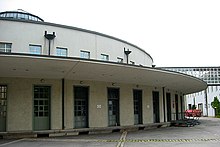Post Building School

The Bavarian Post Building School was the most important manifestation of New Building in Bavaria between 1920 and 1934. The initiators of this school are Robert Poeverlein and, above all, Robert Vorhoelzer with the Munich post office buildings on Tegernseer Platz and Goetheplatz. Important representatives include Walther Schmidt , Hanna Löv and Sep Ruf .
history
Emergence
With the State Post Treaty of 1920 , Bavaria established a separate department of the Reich Ministry of Post based in Munich, the so-called Department VI, as a sign of independence despite the transition from the Bavarian State Post to the German Reich Post in Berlin . An independent post office building department was set up in this department. Numerous modernist architects around Robert Poeverlein and Robert Vorhoelzer , the heads of the construction department, used this space to build new buildings in the New Building style.
Post construction school until 1933
In addition to Vorhoelzer, above all Walther Schmidt and Hanna Löv are to be mentioned as pioneers of this “Bavarian Modernism” in architecture. Until the National Socialists came to power in 1933, the architecture of the Post Building School shaped the entire post building industry in Bavaria. This was mainly due to the increased demand for office buildings of the post office - between 1920 and 1935 around 350 buildings were built in villages and small towns. The former rural post office in Penzberg was the first building in a project series "rural post office". Particularly noteworthy is the experimental estate on Arnulfstrasse in Munich, where the Munich kitchen was also developed, a functional kitchen with an open passage to the dining room and largely glazed walls to remove the isolation of women in the kitchen.
Post construction school in National Socialism
On February 27, 1934, the Postal State Treaty was suspended by the law to simplify and reduce the cost of administration, and Department VI was dissolved. The postal construction industry in Bavaria was thus also under the control of the Berlin Reich Ministry of Post. Vorhoelzer was put into provisional retirement in 1935 and Poeverlein, who wanted to spread Vorhoelzer's ideas, was relieved of his post. Then the architects of the Post Building School worked mainly in the armaments industry (air force buildings) and in rural areas, where they tried to implement elements of modern architecture, at least in part. The thesis that was often expressed earlier that the industrial building was a "secret refuge" for modernist architects has only proven to be partially viable, as the industrial buildings in particular were very often built after the outbreak of war with the help of forced labor or prisoners of war and were mainly used for armaments production. After 1933, the standardization of post office construction progressed significantly, so that in 1937 prefabricated solutions were available for the roof shape, floor plan and facade. In addition, the decree on “Art in Architecture” in 1934 stipulated handicraft guidelines that required folk decoration (for example in the form of frescoed murals ).
Important buildings
- 1922–1924: Oberpostdirektion on Arnulfstrasse, Munich
- 1922–1923: Country post office in Penzberg
- 1925–1926: Parcel delivery office on Arnulfstrasse , Munich (Robert Vorhoelzer and Walther Schmidt)
- 1926–1927: Post Office Ismaninger Strasse, Munich
- 1926–1927: Post Office Agnesstrasse, Munich
- 1928–1929: Trial settlement of the Bavarian Post and Telegraph Association on Arnulfstrasse, Munich
- 1928–1929: Post office on Tegernseer Landstrasse , Munich
- 1928–1930: Main Post Office , Pirmasens
- 1929: Post office on Sonnenstrasse , Munich (conversion of the women's brewery by Friedrich Bürklein )
- 1929–1930: Country post office in Grünwald
- 1929–1931: Coburg main post office
- 1929–1931: Post office and residential building on Fraunhoferstraße, Munich
- 1929–1931: Main Post Office, Neustadt an der Weinstrasse
- 1931–1932: Post office and residential building on Goetheplatz , Munich
- 1931–1932: Post office and residential building at Harras, Munich
- 1933: Bad Kissingen post office
- 1933–1934: Bad Tölz post office
- 1934: Ebenhausen- Schäftlarn post office
Architects of the Post Building School
literature
- Federal Ministry for the Post and Telecommunications (Ed.):
- Handheld dictionary of postal services . Volume 1: A-F. 3. Edition. Berlin 1971, pp. 211-225.
- Post offices. Stuttgart 1989.
- Florian Aicher: The country post office. In: Florian Aicher, Uwe Drepper (Ed.): Robert Vorhoelzer - An architect's life. The classic modernity of the Post. Munich 1990, pp. 212-216.
- Friedrich Bauer, Alfred Wiedenmann: The Bavarian Post Building School (1920-1934). In: Florian Aicher, Uwe Drepper (Ed.): Robert Vorhoelzer - An architect's life. The classic modernity of the Post. Munich 1990, pp. 152-157.
- Rudolf Duffner: The post house in the course of time with special consideration of the post construction facilities in Germany. Berlin 1936.
- Heinrich Götzger: Buildings of the German Reichspost. Berlin 1942.
- Winfried Nerdinger (Ed.): Building under National Socialism, Bavaria 1933–1945. Architekturmuseum der TU-München, Munich 1993, pp. 369–370.
- Winfried Nerdinger (Ed.): Walther Schmidt 1899–1993. From the Post Building School to the City Planning Council of Augsburg. Reimer, Berlin 2008. ISBN 3-496-01383-4 .
- Walther Schmidt : Official buildings. Designed from operational processes, illustrated using the example of the Bavarian post office buildings. Ravensburg 1949.
- Wolfgang Voigt: From the Post Building School to Air Force Modernism. In: Florian Aicher, Uwe Drepper (Ed.): Robert Vorhoelzer - An architect's life. The classic modernity of the Post. Munich 1990, pp. 162-167.




